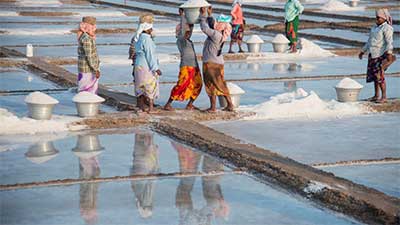Date: 04/04/2023
Relevance: GS-2: Government Policies and Interventions for Development in various sectors and Issues arising out of their Design and Implementation.
Key Phrases: Global Report on Sodium Intake Reduction, sodium score, low- and middle-income countries (LMICs), National Family Health Survey-5, Food Safety and Standards Authority of India (FSSAI), ‘Eat Right India’ movement
Context:
- The WHO recently published a first-of-its-kind ‘Global Report on Sodium Intake Reduction,’ which sheds light on the progress of its 194 member states towards reducing population sodium intake by 30% by 2025.
- Regrettably, progress has been lethargic, with only a few countries making considerable headway towards the objective. Consequently, there is a proposal to extend the deadline to 2030.
How India is doing?
- An average Indian’s sodium consumption is more than double the
physiological need and dramatically exceeds the World Health
Organization’s (WHO) recommended daily intake of <5 g of salt for
adults.
- The WHO devised a sodium score, ranging from 1 (least implementation) to 4 (highest implementation), for each member state based on factors such as the extent of implementation of sodium reduction and other related measures.
- India’s score of 2 signifies the presence of at least one voluntary policy, emphasising the need for more rigorous efforts to address this health concern.
Why is it essential for India to reduce its sodium intake?
- Health Impact:
- Empirical evidence highlights the strong correlation between
reduced sodium intake and decreased blood pressure.
- As per a seminal paper in the BMJ, lowering sodium intake by 1 gram per day (2.5 grams of salt) leads to a 5 mm Hg reduction in systolic blood pressure (BP) for individuals aged 55, causing an estimated 22% decrease in stroke incidence and a 16% decrease in myocardial infarction incidence.
- Elevated BP is a critical risk factor for cardiovascular disease, the foremost cause of mortality worldwide.
- Empirical evidence highlights the strong correlation between
reduced sodium intake and decreased blood pressure.
- Economic Impact:
- In low- and middle-income countries (LMICs) it is estimated at $3.7 trillion between 2011 and 2025 due to premature mortality and disability. This figure represents an alarming 2% of the GDP of LMICs.
- Notably, the World Economic Forum projects that the Indian economy alone faces losses surpassing $2 trillion between 2012 and 2030 as a consequence of cardiovascular disease.
Significant challenges in India:
- As per data from the Registrar General of India, WHO, and the Global Burden of Disease Study, cardiovascular diseases have emerged as the primary cause of mortality and morbidity. In the last 25 years, the age-adjusted cardiovascular disease mortality rate has risen by 31%. Hypertension has been identified as the leading risk factor for such diseases in India.
- As per National Family Health Survey-5 reveals that hypertension is more prevalent among men aged 15 and above compared to women in the same age group and is more common in southern States, particularly Kerala, while Punjab and Uttarakhand in the north also report high incidence rates.
- The 2020 Report on Medical Certification of the Cause of Death shows that circulatory system diseases account for 32.1% of all documented deaths, with hypertension being a major risk factor.
Initiatives undertaken by the Government:
- The Food Safety and Standards Authority of India (FSSAI) has implemented the ‘Eat Right India’ movement, which strives to transform the nation’s food system to ensure secure, healthy, and sustainable nutrition for all citizens.
- In line with this goal, the FSSAI launched a social media campaign called ‘Aaj Se Thoda Kam.’ However, the average Indian’s sodium intake remains alarmingly high. Evidence shows an average daily consumption of approximately 11 grams.
Way Forward:
- India needs a comprehensive national strategy to curb salt consumption, as current measures have fallen short.
- A multi-pronged approach, engaging consumers, industry, and the government, is crucial.
- Collaboration between State and Union governments is essential to combat hypertension, often caused by excessive sodium intake.
- Implementing highly cost-effective sodium reduction policies could save an estimated 7 million lives globally by 2030. It is an important component of action to achieve the Sustainable Development Goal target of reducing deaths from non-communicable diseases. But today, only nine countries (Brazil, Chile, Czech Republic, Lithuania, Malaysia, Mexico, Saudi Arabia, Spain and Uruguay) have a comprehensive package of recommended policies to reduce sodium intake.
Source: The Hindu
Mains Question:
Q. As per data from the Registrar General of India, WHO, and the Global Burden of Disease Study, cardiovascular diseases have emerged as the primary cause of mortality and morbidity. Analyse the causes and suggest a way forward. (150 words).






















